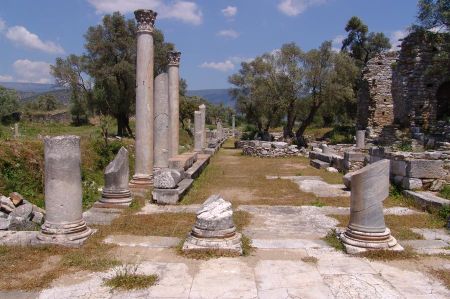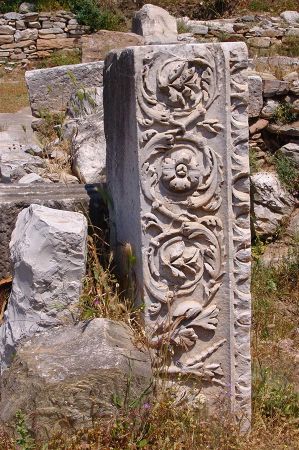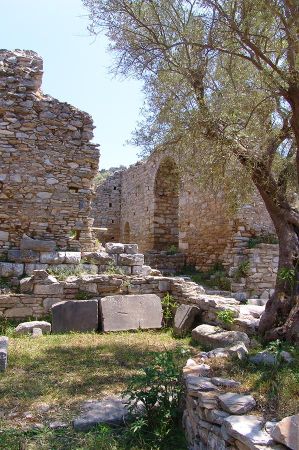Iasos - Hellenistic city founded near Euromos
- Written by Portal Editor
The tip of a real admirer of Greek cultural buildings, whom we met in Euromos, led us to take a detour over the mountains to the coast: Iasos was the next destination.
Until now little known in cultural tourism, we found a village that has been preserved in its original state and lives mainly from fishing and the olive harvest.
The three temples of Zeus Megistos, Apollo and Artemis in Iasos
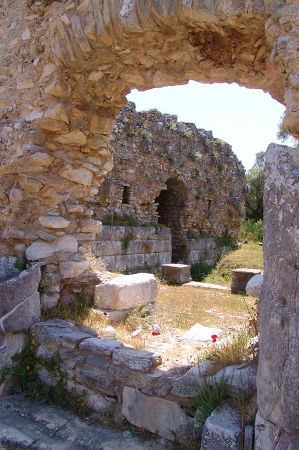 Driving from Euromos towards Milas, turn right towards the village of Kıyıkışlacık and follow the road over the ridge. Once in the village, you reach the natural harbor and on the left you can already see the first ruins of the ancient Ionian city of Iasos. Iasos was originally built on the island mountain off the coast because there was a natural harbor with a narrow entrance there. However, changes in the surface structure, sand deposits and human intervention have created a connection to the mainland, so that today a road leads directly into the town.
Driving from Euromos towards Milas, turn right towards the village of Kıyıkışlacık and follow the road over the ridge. Once in the village, you reach the natural harbor and on the left you can already see the first ruins of the ancient Ionian city of Iasos. Iasos was originally built on the island mountain off the coast because there was a natural harbor with a narrow entrance there. However, changes in the surface structure, sand deposits and human intervention have created a connection to the mainland, so that today a road leads directly into the town.
Italian excavations on site have confirmed that this place was already inhabited in the Bronze Age, and finds from Iasos are now in the museums of Izmir, Bodrum and Milas. The excavation and restoration of the so-called fish market, an imposing building complex in the middle of the village, was only recently completed. Unfortunately, everything was closed when we visited.
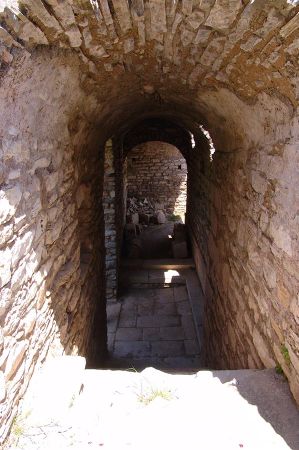 The settlement and expansion of the ancient city of Iasos to the left of the harbor was driven forward in the 9th century BC, initially from Greece and later from Milas. A large part of the city complex, such as the city wall, the agora, the three temples of Zeus Megistos, Apollo and Artemis and also the town hall, date from the Hellenistic period, while the theater, the bouleuterion, the gymnasium and the aqueduct date from Roman times, as evidenced by numerous inscriptions found.
The settlement and expansion of the ancient city of Iasos to the left of the harbor was driven forward in the 9th century BC, initially from Greece and later from Milas. A large part of the city complex, such as the city wall, the agora, the three temples of Zeus Megistos, Apollo and Artemis and also the town hall, date from the Hellenistic period, while the theater, the bouleuterion, the gymnasium and the aqueduct date from Roman times, as evidenced by numerous inscriptions found.
Like Miletus, Iasos belonged to the Attic League, was temporarily under Persian rule and belonged to the Roman province of Asia from 129 BC. The city of Iasos was populated until the late 15th century, only then was the city abandoned.
In late antiquity, Iasos was also the seat of a bishop who belonged to the ecclesiastical province of Stauropolis and thus the Latin form of the name titular bishopric of Iasos goes back to the Roman Catholic Church.
Tourism is slowly developing
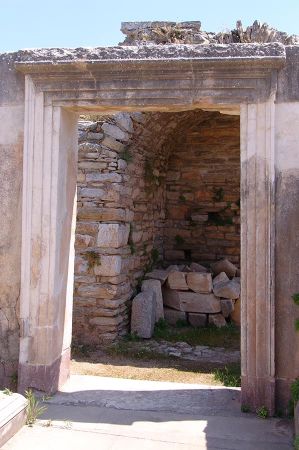 The most interesting ruins of Iasos are on the left hand side at the foot of the castle hill, so after a short walk you first come to the Agora, the market square of the trading city with still preserved columns and wonderful paving made of huge polished marble blocks, then you come to the town hall with its meeting room and the marble seats arranged in a circle, see the first parts of the imposing city wall, graves and the remains of the old theater. There was also a tax office in Iasos, another indication of the importance of the city. On the way up to the fortress you can find ruins of the old houses. A walk along the former fortress wall allows you to see the surroundings and the harbor entrance with the two fortress towers, which still protrude from the water on at least one side, is particularly interesting. It is very easy to imagine that the harbor entrance was closed with a chain to prevent the harbor from being attacked at night.
The most interesting ruins of Iasos are on the left hand side at the foot of the castle hill, so after a short walk you first come to the Agora, the market square of the trading city with still preserved columns and wonderful paving made of huge polished marble blocks, then you come to the town hall with its meeting room and the marble seats arranged in a circle, see the first parts of the imposing city wall, graves and the remains of the old theater. There was also a tax office in Iasos, another indication of the importance of the city. On the way up to the fortress you can find ruins of the old houses. A walk along the former fortress wall allows you to see the surroundings and the harbor entrance with the two fortress towers, which still protrude from the water on at least one side, is particularly interesting. It is very easy to imagine that the harbor entrance was closed with a chain to prevent the harbor from being attacked at night.
Until the population exchange with Greece, Kıyık was also inhabited almost exclusively by Greeks. Tourism is slowly developing, especially sailors from the Gulf of Güllük like to stop off in Iasos. In the summer months there is also regular boat traffic from Güllük to enjoy the variety of fish on offer in the small, simple harbor restaurants.
Plan a stop of several hours in Iasos. Good shoes are recommended. Best time: spring and autumn.
Iasos - An Ancient Pearl in Turkey
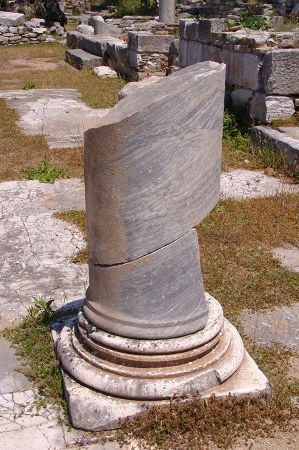 The ancient city of Iasos (also spelled "Iassos") is located on the west coast of Turkey in the Karia region, near the modern-day city of Milas in the Muğla province. Located right on the Gulf of Güllük, this historic gem is an impressive testament to Greek and Roman civilization and a must-see for history and archaeology lovers.
The ancient city of Iasos (also spelled "Iassos") is located on the west coast of Turkey in the Karia region, near the modern-day city of Milas in the Muğla province. Located right on the Gulf of Güllük, this historic gem is an impressive testament to Greek and Roman civilization and a must-see for history and archaeology lovers.
The History of Iasos
Foundation and Antiquity
Believed to have been founded in the 3rd millennium BC, Iasos was a major port city. Due to its strategic location on the Aegean Sea, the city was an important trading center and was influenced by various civilizations, including the Greeks, Romans and Byzantines.
Heyday under the Greeks and Romans
During Greek and Roman rule, Iasos experienced a cultural and economic heyday. The city was known for its abundance of fish and its luxurious marble buildings. Its importance is also evident in the well-preserved ruins that can still be visited today.
Things to do in Iasos
 The Ancient Theatre
The Ancient Theatre
The impressive Theatre of Iasos is built into the side of a hill and can accommodate around 3,500 spectators. From here you can enjoy stunning views of the ruins of the town and the surrounding countryside.
The Agora
The Agora was the heart of public life in Iasos. It served as a marketplace and meeting place and is now a fascinating place to understand the structure of ancient life.
The Port and City Walls
The ancient port of Iasos testifies to the maritime importance of the town. The remains of the city walls that once protected the town are also impressive and provide an insight into the defensive strategies of the ancient world.
The Bouleuterion
The Bouleuterion, an assembly building for the town council, is one of the best-preserved structures in Iasos. It shows the political organisation of the town in ancient times.
The Necropolis
The Iasos Necropolis, located outside the city walls, contains numerous tombs and sarcophagi richly decorated with reliefs and inscriptions.
Iasos Today
 A Place of Peace and Inspiration
A Place of Peace and Inspiration
Iasos today is an idyllic place that has largely been spared from mass tourism. The mix of ancient ruins, the crystal-clear waters of the Gulf of Güllük and the peaceful atmosphere make it a perfect destination for travellers who appreciate history and nature in equal measure.
Archaeological Work
Archaeologists continue to work to unlock the mysteries of Iasos. New discoveries enrich our knowledge of life in ancient times and make the city a vibrant research site.
Conclusion
Iasos is a hidden gem that combines history, culture and nature in a unique way. For anyone who wants to travel Turkey and discover the ancient world, a visit to Iasos is an unforgettable experience.
Tip: Combine your visit to Iasos with a trip to Milas or the nearby beaches to fully enjoy the beauty of the Aegean Sea.
Please read as well:
Miletus at the Bay of Milet next to Menderes river
Datça - pretty, quiet harbour at the Aegean
-
 Iasos Ancient Town near Euromos
Iasos Ancient Town near Euromos
Iasos Ancient Town near Euromos
Iasos Ancient Town near Euromos
-
 Iasos Ancient Town near Euromos
Iasos Ancient Town near Euromos
Iasos Ancient Town near Euromos
Iasos Ancient Town near Euromos
-
 Iasos Ancient Town near Euromos
Iasos Ancient Town near Euromos
Iasos Ancient Town near Euromos
Iasos Ancient Town near Euromos
-
 Iasos Ancient Town near Euromos
Iasos Ancient Town near Euromos
Iasos Ancient Town near Euromos
Iasos Ancient Town near Euromos
-
 Iasos Ancient Town near Euromos
Iasos Ancient Town near Euromos
Iasos Ancient Town near Euromos
Iasos Ancient Town near Euromos
-
 Iasos Ancient Town near Euromos
Iasos Ancient Town near Euromos
Iasos Ancient Town near Euromos
Iasos Ancient Town near Euromos
-
 Iasos Ancient Town near Euromos
Iasos Ancient Town near Euromos
Iasos Ancient Town near Euromos
Iasos Ancient Town near Euromos
-
 Iasos Ancient Town near Euromos
Iasos Ancient Town near Euromos
Iasos Ancient Town near Euromos
Iasos Ancient Town near Euromos
-
 Iasos Ancient Town near Euromos
Iasos Ancient Town near Euromos
Iasos Ancient Town near Euromos
Iasos Ancient Town near Euromos
-
 Iasos Ancient Town near Euromos
Iasos Ancient Town near Euromos
Iasos Ancient Town near Euromos
Iasos Ancient Town near Euromos
-
 Iasos Ancient Town near Euromos
Iasos Ancient Town near Euromos
Iasos Ancient Town near Euromos
Iasos Ancient Town near Euromos
-
 Iasos Ancient Town near Euromos
Iasos Ancient Town near Euromos
Iasos Ancient Town near Euromos
Iasos Ancient Town near Euromos
-
 Iasos Ancient Town near Euromos
Iasos Ancient Town near Euromos
Iasos Ancient Town near Euromos
Iasos Ancient Town near Euromos
-
 Iasos Ancient Town near Euromos
Iasos Ancient Town near Euromos
Iasos Ancient Town near Euromos
Iasos Ancient Town near Euromos
-
 Iasos Ancient Town near Euromos
Iasos Ancient Town near Euromos
Iasos Ancient Town near Euromos
Iasos Ancient Town near Euromos
-
 Iasos Ancient Town near Euromos
Iasos Ancient Town near Euromos
Iasos Ancient Town near Euromos
Iasos Ancient Town near Euromos
-
 Iasos Ancient Town near Euromos
Iasos Ancient Town near Euromos
Iasos Ancient Town near Euromos
Iasos Ancient Town near Euromos
-
 Iasos Ancient Town near Euromos
Iasos Ancient Town near Euromos
Iasos Ancient Town near Euromos
Iasos Ancient Town near Euromos
https://www.alaturka.info/en/turkey-country/aegean/6846-iasos-hellenistic-city-founded-near-euromos#sigProId3011fd41ec
